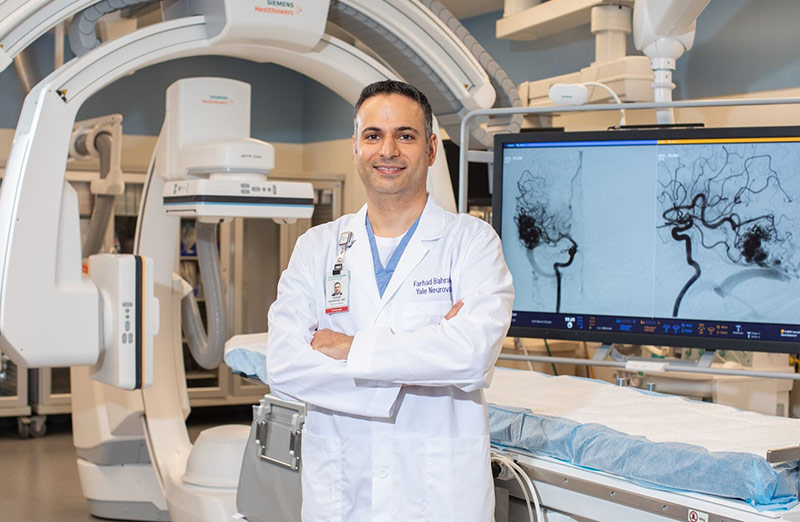
Popular Locations
- Outpatient Surgery - Bridgeport Hospital
- Park Avenue Medical Center
- Primary Care Center - Bridgeport Hospital


When it comes to stroke, seconds count. Stroke is a medical emergency that requires a timely response to reduce the damage it can cause when blood flow to part of the brain is interrupted. At Bridgeport Hospital’s Stroke Center, a team of experts provides ‘round-the-clock care seven days a week.
“Remember the mantra, ‘Time is brain,’” said Charles Matouk, MD, a cerebrovascular neurosurgeon who coordinates neurovascular, surgical and interventional care across the Yale New Haven Health System, including Bridgeport Hospital’s Stroke Center, and is associate professor of Neurosurgery and Radiology & Biomedical Imaging at Yale School of Medicine. This is equally important for patients experiencing either an ischemic or hemorrhagic stroke, two different types of stroke that require different types of treatment.
For ischemic stroke, timely intervention is critical because the brain is not getting enough blood and it can die," Dr. Matouk explained. "In the case of hemorrhagic stroke, you want to get the patient's blood pressure well controlled, and you want to counteract any blood-thinning effects to prevent expansion of the bleed inside the brain that can cause further damage.
Ischemic stroke is caused by a blood clot or a blood vessel blockage in the brain. Many patients with this type of stroke can be treated effectively with clot-busting drugs, provided the patient arrives at the emergency department as soon as symptoms are recognized. “You have about four-and-a-half hours to get a clot-busting medication,” Dr. Matouk explained.
Thrombolytic drugs are given intravenously within three hours of stroke onset (and up to 4.5 hours in some patients) to break apart a clot that is blocking blood flow within the brain.
Ischemic stroke can be treated with mechanical thrombectomy. During this minimally invasive procedure, the blood clot is removed from the brain and then blood flow to the brain is restored. This emergency treatment may be of benefit up to 24 hours after stroke onset.
Hemorrhagic stroke is caused by weakened vessels that rupture and bleed into the brain and requires specialized medical or surgical interventions that are available at Bridgeport Hospital. The Stroke Center is part of an integrated program supported by the expertise of Yale Medicine.
“One of the newest tools we have for thrombectomy for ischemic stroke patients is an advanced biplane neuro-angiography imaging system,” said Farhad Bahrassa, MD a neurosurgeon at Bridgeport Hospital and assistant professor of Neurosurgery at Yale School of Medicine.
Recently installed at Bridgeport Hospital, the new biplane technology, made possible through the philanthropic support of the Elizabeth M. Pfriem Foundation, provides clear visualization and lower radiation exposure for patients.
“There is continuous real-time imaging in both 2D and 3D, which can be combined on the same screen for the most sophisticated viewing,” Dr. Bahrassa explained.
The new system will support care and treatment for all stroke types, brain aneurysms, brain tumors, complex spine conditions and carotid artery disease procedures, as well as other conditions treated by interventional radiologists at Bridgeport Hospital’s Joel E. Smilow Heart Institute, part of Yale New Haven Health’s Heart and Vascular Center.
In addition to offering advanced technology, the Stroke Center, which is certified by The Joint Commission as an Advanced Primary Stroke Center, is staffed by a core team of neurologists, endovascular and neurovascular neurosurgeons, emergency medicine and intensive care physicians, radiologic technologists, radiologists and nurses, including stroke-certified registered nurses.
As time is of the essence in stroke treatment, recognizing the symptoms is critical. A convenient acronym to remember is “B-E-F-A-S-T,” which stands for:
“If you’re experiencing symptoms of stroke, get help fast,” Dr. Matouk advises. “If you live in the greater Bridgeport area, know that you live in a community that offers a lot of expertise in the clinical management of stroke.”
The Bridgeport Hospital Stroke Center offers a complete program that emphasizes rapid, advanced care for patients with stroke and complex neurovascular conditions.